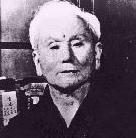
Gichin Funakoshi
( 1869 - 1945 )
The following biography is quoted in a number of different sources on the internet. The original author is undetermined.
Some of the information is excerpted from The History of Karate, by Morio Higaonna.*
In 1906, Gichin Funakoshi held the first public karate demonstration in Okinawa. He is one of the most important people in modern day karate. He was born in Okinawa and a student of Anko Itosu and Anko Azato. He later wrote a number of influential books about karate which spread beyond Okinawa.
Unflattering stories abound about him: he was accused of simplifying and changing katas because he did not understand them; supposedly he never learned the kata Hakutsuru ("White Crane") because nobody wished to teach it to him due to his egocentricity and bad attitude. Nonetheless, his contributions to the spread of karate around world cannot be underestimated nor should they be minimized, regardless of his alleged personality flaws.
In 1917, Funakoshi and his students journeyed to Kyoto and demonstrated karate for the first time in Japan. Then, four years later, he demonstrated for Crown Prince Hirohito in Okinawa which led to engagements at the National Athletic Exhibition in Tokyo and the Kodokan (the judo headquarters
in Tokyo). After this, Funakoshi stayed in Tokyo and eventually began teaching karate in Japanese Universities.
It was the influence of these University students with interests in Zen Buddhism which led Funakoshi to formally adopt the name karate-do "way of the empty hand" for his style. Posthumously the style was known to his students as Shotokan "hall of Shoto" which referred to their training hall and to Funakoshi's pen-name, Shoto.
Another important step in the recognition of karate came in 1930 when the Dai Nippon Butokukai, the Japanese headquarters for all their martial arts, allowed karate into its organization. It was only after this time, in October of 1936, that Okinawan martial arts leaders held a conference and decided to formally adopt the term karate (empty hand) to describe the Okinawan martial arts.
From this time onward, a proliferation of karate styles came into the open, as did their teachers. This spread of Okinawan and Japanese karate styles is so complex and entwined that a single table showing all of their relationships is near impossible.

|

